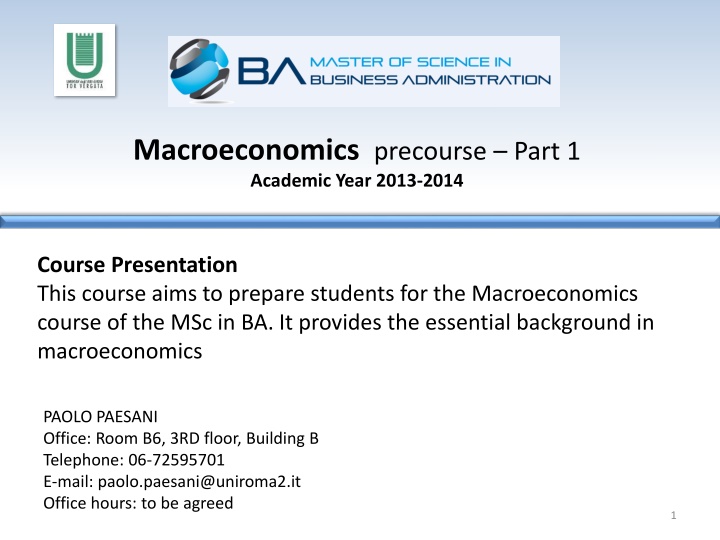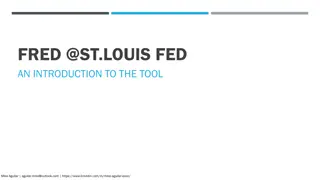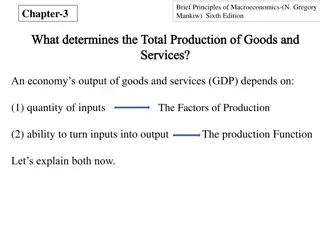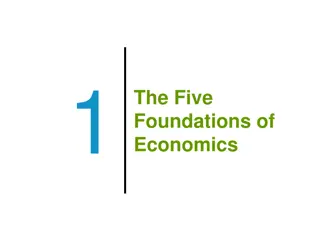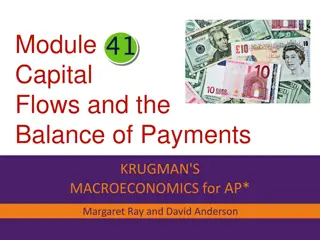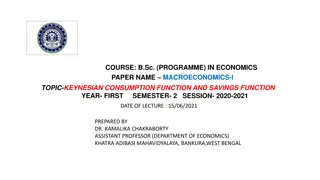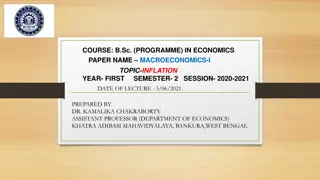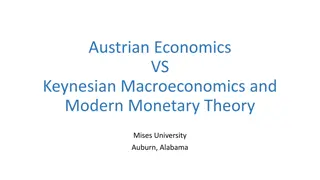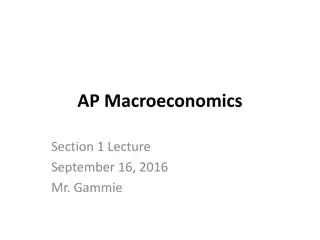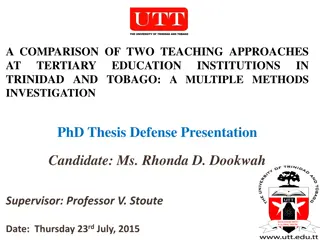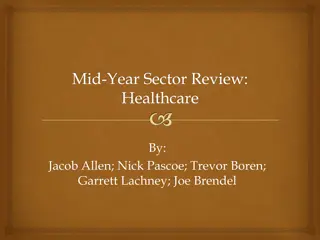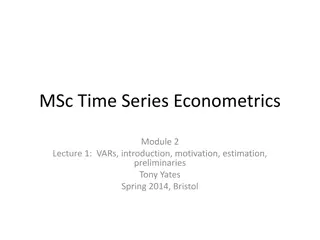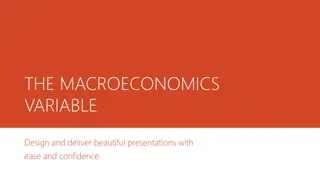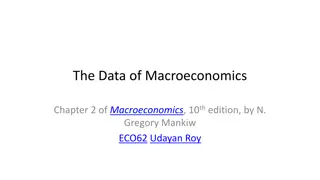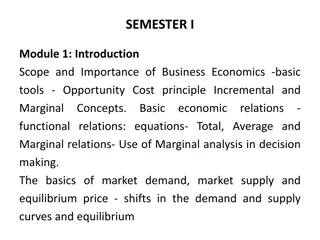Macroeconomics
Macroeconomics explores the functioning of national economic systems and their interactions. It covers property rights, resource allocation, capitalist economies, and the role of governments. The course prepares students for advanced studies in macroeconomics, focusing on the fundamental concepts and key actors in the economy such as households, companies, financial intermediaries, and government. Topics include money as a medium of exchange, the economic system, government functions, and the financial system.
Uploaded on Mar 03, 2025 | 0 Views
Download Presentation

Please find below an Image/Link to download the presentation.
The content on the website is provided AS IS for your information and personal use only. It may not be sold, licensed, or shared on other websites without obtaining consent from the author.If you encounter any issues during the download, it is possible that the publisher has removed the file from their server.
You are allowed to download the files provided on this website for personal or commercial use, subject to the condition that they are used lawfully. All files are the property of their respective owners.
The content on the website is provided AS IS for your information and personal use only. It may not be sold, licensed, or shared on other websites without obtaining consent from the author.
E N D
Presentation Transcript
Macroeconomics precourse Part 1 Academic Year 2013-2014 Course Presentation This course aims to prepare students for the Macroeconomics course of the MSc in BA. It provides the essential background in macroeconomics PAOLO PAESANI Office: Room B6, 3RD floor, Building B Telephone: 06-72595701 E-mail: paolo.paesani@uniroma2.it Office hours: to be agreed 1
Macro MACROECONOMICS Macroeconomics is a branch of economic theory that studies the functioning of the economic system of a nation as a whole and its connections with other economic systems. Economic system = Households + Non financial Companies + Financial Intermediaries + Government (including the central bank) Orthodox approach: Microeconomics (study of single elements) as the basis of macroeconomics (study of the whole) Heterdox approach: I ll tell you about it next time ! 2
Macro SOCIO-ECONOMIC CONTEXT Well-defined property rights over available resources; Freedom to put available resources to the best (most profitable) use as judged by the owner (resource allocation); Property rights protection; Freedom to transfer property rights in a regulated and organised way (Voluntary exchange); Price-based resource allocation; Capitalist economy; Open economy; Government as a relevant macroeconomic actor Money as medium of exchange, means of payment, unit of account and store of value. 3
Macro THE ECONOMIC SYSTEM Mankiw (2010) 4
Macro GOVERNMENT AS A PART OF THE ECONOMIC SYSTEM Government as a part of the economic system 1. Purchases goods and services from the private sector (linkage with the market for goods and services); 2. Hires workers and rents capital goods from the private sector which it uses in combination with intermediate goods and services to produce public goods (linkage with the market for factors of production); 3. Taxes houselds and firms (direct taxation, indirect taxation, excises and fees) (TAX) 4. Transfers money to houselds and firms (pensions, unemployment benefits, subsidies) GOVERNMENT Mankiw (2011) 5
Macro FINANCIAL SYSTEM AS A PART OF THE ECONOMIC SYSTEM Financial system (institutions and markets related to the circulation of money and credit) : 1. Central bank; 2. Monetary financial institutions (normal banks); 3. Non monetary financial intermediaries (investment and pension funds, insurance companies, rating agencies, investement banks .) 4. Money markets (Short-term financial assets) 5. Financial markets (bonds, shares, derivatives, forex, commodities) GOVERNMENT 6
Macro THE GLOBAL ECONOMIC SYSTEM Every economic system is linked to the others through multiple channels: 1. International trade of goods and services (Exports and Imports); International mobility of factors of production (migration, foreign direct investment); Private international financial flows (portfolio investment, forex transactions) Public international financial flows (management of official forex reserves, interntional aid, international transfers) 2. GOVERNMENT 3. 4. 7
Macro GROSS DOMESTIC PRODUCT Gross Domestic Product (GDP, Y) is the nominal value of all the final goods and services produced within a country over a given period of time evaluated at market prices. 1. 2. nominal value = measured in terms of money Final goods and services = goos and services produced over a given period of time and NOT USED to produce other goods and services during the same period of time. Produced = Trading of second hand goods is not part of GDP Within a country = National dimension Given period of time = Usually One year (flow variable) Market prices = Only final goods and services regularly bought and sold in a market contribute to GDP. 3. 4. 5. 6. 8
Macro GROSS DOMESTIC PRODUCT Raw Bread Wheat Primary sector AGRICULTURE Secondary sector INDUSTRY Tertiary sector SERVICES 100 EUR 50 EUR 150 EUR Packaged bread Total value of goods and services = 300 EUR Value of intermediate goods and services = 150 EUR GDP = 150 EUR Gross National Income = 50 + (100-50) + (150 100) = 150 EUR Consumers 9
Macro GROSS NATIONAL PRODUCT Gross National Product (GNP) is the nominal market value of all the final goods and services produced within a country or a abroad over a given period of time by national factors of production. GNP = GDP + NFI NFI = NET FOREIGN INCOMES = (Income of domestic labour and capital employed abroad) (Income of foreign labour and capital employed in the country) Nationality + Residence matter 10
Macro NATIONAL INCOME Gross National Income (GNI) is equal to Gross National Income minus Indirect Taxation (ex. VAT) GNI = GNP - VAT Hint: When you buy anything (eg. a book) , 20% of the price you pay is VAT and is trasferred to the State, the rest compensates factors of production employed to produce it. 11
Macro OTHER MEASURES OF INCOME Mankiw (2011) 12
Macro GDP PER CAPITA Dividing GDP by the country s population (POP) we obtain GDP per-capita. GDP per capita can be taken as a rough measure of the economic welfare of a country s residents. GDP per capita = GDP / POP GDP per capita is an average that tells us nothing about distribution. Economists and statisticians have developed specific indicators for that (e.g. Lorenz Curve, Gini coefficient, ) 13
Macro GDP PER CAPITA Source: BNP_perhoofd_2012_%281%29.PNG 14
Macro GDP = AGGREGATE DEMAND Y = C + I + G + X M Mankiw (2011) 15
Macro AGGREGATE DEMAND: CONSUMPTION Aggregate consumption depends on: Current disposable income (Ydisp= Y TAX + TRA) dC/dYdisp> 0 Expected disposable income dC/dYexp> 0 Inflation (?), Real interest rate < 0 (?) Wealth = Financial assets + Real assets > 0 Income distribution , Consumer credit . 1. 2. 3. 4. 5. Ydisp C(t) = S(t) = Private Savings 16
Macro AGGREGATE DEMAND: PRIVATE INVESTMENT Aggregate investment depends on: 1. 2. 3. 4. Expected profits + attitude towards risk Expected aggregate demand Inflation (?), Real interest rate < 0 Credit + financial factors K(t+1) K(t) = I(t) dK(t) = Net investement K(t) = Aggregate Stock of capital , 0< d <1 depreciation rate 17
Macro AGGREGATE DEMAND: GOVERNMENT PURCHASES Government purchases depend on: 1. 2. Size of the public sector Fiscal policy decisions G(t) + TRA(t) TAX(t) = Government budget deficit GBD = change in public debt + monetary financing of BD 18
Macro AGGREGATE DEMAND: NEXT EXPORTS Net Exports depend on: 1. Nominal exchange rate E (amount of foreign currency per unit of domestic currency) dNX / dE < 0 Domestic price level P dNX / dP < 0 Foreign price level P* dNX / dP* > 0 Domestic GDP Y dNX / dY < 0 Foreign GDP Y* dNX / dY* > 0 Barriers to international trade Quality, National specificities 2. 3. 4. 5. 6. 7. NX (t) + NFI(t) + NFTRA(t) + FDI(t) + PRMK(t) + dRES (t) + EO(t) = 0 Balance of payments 19
Macro DECOMPOSING GDP Y = PQ where Y = Nominal GDP, P = GDP deflator, Q = real GDP Mankiw (2011) 20
Macro INFLATION Inflation rate = Rate of change of the GDP deflator over time = [P(t) P(t-1)] / P(t-1) 1. > 0 = Moderate Inflation 2. = 0 (approx.) = Stable prices 3. < 0 = Deflation 4. >> 0 = High Inflation 5. >>>>>> 0 = Hyper-inflation 21
Macro INFLATION AND THE PURCHASING POWER OF MONEY 1/P can be taken as an indicator of the purchasing power of money (amount of goods which can be purchased spending 1 euro) 1. M/P = Real Money balances 2. W/P = Real wage Inflation erodes the purchasing power of money. As such creditors and people on fixed income fear it while debtors and people on floating income do not (if their income move at the place of inflation). Interesting link on the effects of inflation: http://203.200.22.249:8080/jspui/bitstream/123456789/2209/1/A_tract_on_moneta ry_reform.pdf 22
Macro MEASURING INFLATION Mankiw (2011) 23
Macro GROWTH Inflation rate = Rate of change of the real GDP over time = [Q(t) Q(t-1)] / Q(t-1) 1. > 0 = Growth 2. = 0 (approx.) = Stagnation 3. < 0 = Recession Growth theory is one of the main branches of macroeconomics 24
Macro REAL GDP AND GROWTH Mankiw (2011) 25
Macro REAL GDP AND GROWTH Mankiw (2011) 26
Macro REFERENCE Mankiw, G.N. (2010) Brief Principles of Macroeconomics, 6 ed., 27
